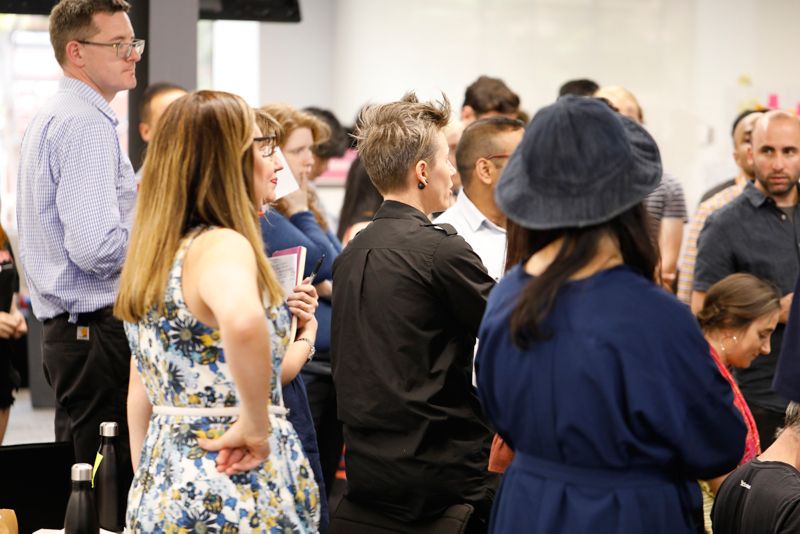
How Activator transformed this Masters program
Claire Boulange first approached Activator to collaborate on designing a course. A researcher at the Healthy Livable Cities group at RMIT Centre for Urban research, she and her colleague Will Moore have designed a Masters intensive course. Lucky for Claire, she was just in time to sign up for the Activator X Kaospilot Transformational Learning masterclass.

This two-day educational design masterclass was created by Danish educational leaders Kaospilot, as a means to explore experiential ways of learning that inspires creativity, innovation and risk in learning spaces.
“So many gimmicky words in the course description,” Claire chuckled. “So I thought: maybe I can learn about facilitating a classroom.”
To her surprise, she learnt that and so much more.
“I had no idea that it would be designed in a way to set up a course,” said Claire. “In retrospect – and it’s something I tell the Healthy Livable Cities group – it would be worthwhile for me, Will and some other people to attend the course much earlier on to design the course as a group together.”
“I was learning tools that get people to think about what their course is trying to achieve, soft skills, reflections. I was like wow, if I had done that thinking before I would have designed the course in a different way.”
Despite having only 3 weeks before she had to commence teaching, Claire decided to give the Integrating Health and Planning course a makeover.
The results were tremendous.
The course received rave reviews from students, who found it a breath of fresh air and felt inspired after the 5 long days of class.
“Many students have said it’s the best course they did in their Masters of Urban Planning programme,” said Will Moore, Program Coordinator at the Healthy Livable Cities Group.
One of these students is Dhavani Modi.
“The Integrating Health and Planning course was very interesting and different from the usual stereotypical subjects we have,” said Dhavani. “It was well taught, creative and empowering for me.”
Many students also bonded with one another and left the course with new friendships.
“It's easy to go through university and not talk to anyone,” said Claire. “I think facilitating and creating a safe space for people to be comfortable to start building friendships is something to be proud of.”

Here is how Activator and its programs helped to transform this Masters course:
The importance of play
Kaospilot strongly emphasises the role of play in learning. By creating safe spaces, students were able to engage in role play and explore different ways of thinking.
Dhavani relished in the use of serious play in their course.
“We had to make our Lego models spontaneously, which showed how everybody has their individual ideas on livability in terms of urban planning,” said Dhavani.
“It was an amazing platform to meet guest speakers everyday and the networking through this course was on point. I did not want the course to end.”
Will was so inspired that he is in the process of creating a board game for his students.
IDOARRT Framework
Claire incorporated the IDOARRT framework into the Integrating Health and Planning course, after being introduced to it at the Activator X Kaospilot masterclass.
IDOARRT stands for intention, desired outcomes, agenda, roles and time. Claire leveraged the framework in the first hour of class to collectively establish expectations early.
Unconventional classrooms
To make the course as interactive as possible, Claire and Will put students into groups early on to foster group dynamics.
"This format was really important because we also had five students from industry, one in each group,” said Will. “it helped us to focus on developing a group dynamic while harnessing the diverse perspectives.”
They also removed tutorials and gave more breaks so that students have more time to reflect on their learning and to work on their own.
Claire also learnt from Kaospilot to introduce a closing ceremony to solidify resolve and integrate their learnings with their ambitions.
"We asked people to stand up and share about what they left behind and what they have developed. For example: ‘I leave behind my negativity and biases and will do my best to build livable cities’. Students really took this onboard and felt empowered afterwards,” said Claire.
Soft skills from Activator workshops
Two workshops facilitated by Leona Norris from Activator were run in the five days. The idea was to build soft skills in students and make them industry ready.
“Activator offers a range of experiential workshops that build 21CC skills, such as adaptability, comfort with risk, opportunity recognition, self-reliance, communication, collaboration, critical thinking and problem solving,” said Leona. “These workshops allow for exploration and reflection of skills through experiences that are purposeful, challenging and fun. ”
One of them was a workshop on pitching as presentation.
“Learning how to pitch was one of the best segments of the course as it was so handy to develop this skill professionally and for our academics too,” said Dhvani.
This was a huge priority for Claire, who understands how important communication skills are in the urban planning industry.
“What I observed in the industry was that you need to be a good communicator in order to be successful,” said Claire. “ As an urban planner, your job is to communicate with people across different industries – engineers, architects, politicians, etc. So you have to develop these soft skills of being able to connect with people of different backgrounds and languages. I want my students to have that.”
“I wasn’t sure how to train people to gain that confidence to be a good speaker. That's why I approached Activator for to do that for me.”
Engaging a new generation of students
The Integrating Health and Planning course was designed as a form of research translation for the Healthy Livable Cities group. Although there are plenty of skills and knowledge that can be transferred to students, the skill of teaching may not always come naturally to academics.
“I’m a researcher, so 100 per cent of my time is focused research. I'm not employed as a lecturer, but there is an assumption that [researchers] are natural lecturers,” admitted Claire. “We’ve all been in classrooms with terrible lecturers and I would hate to be that person.”
“Students today have a smaller attention span, so there's all sorts of things to take into account. How do you deal with technology in the classroom, diverse backgrounds, etc.”
By engaging in Activator training, Claire and Will picked up skills in educating a new generation of students.
“Activator has the skills and knowledge and tools to better equip lecturers to deliver engaging content,” said Will.
Story by Jing Lee
Related News
Acknowledgement of Country
RMIT University acknowledges the people of the Woi wurrung and Boon wurrung language groups of the eastern Kulin Nation on whose unceded lands we conduct the business of the University. RMIT University respectfully acknowledges their Ancestors and Elders, past and present. RMIT also acknowledges the Traditional Custodians and their Ancestors of the lands and waters across Australia where we conduct our business.